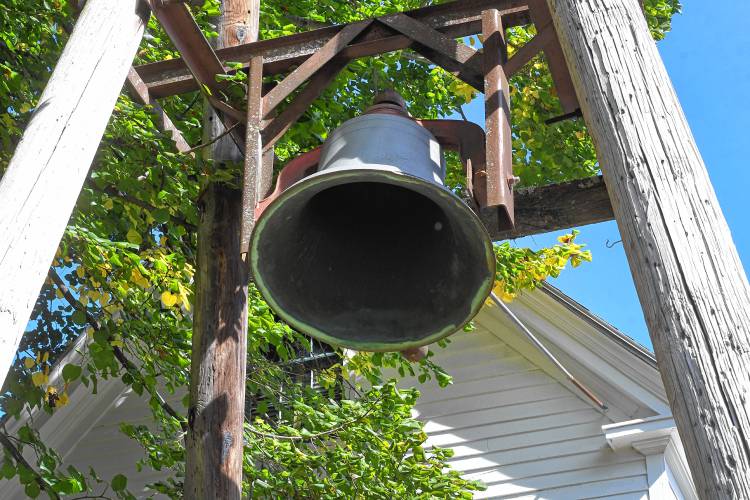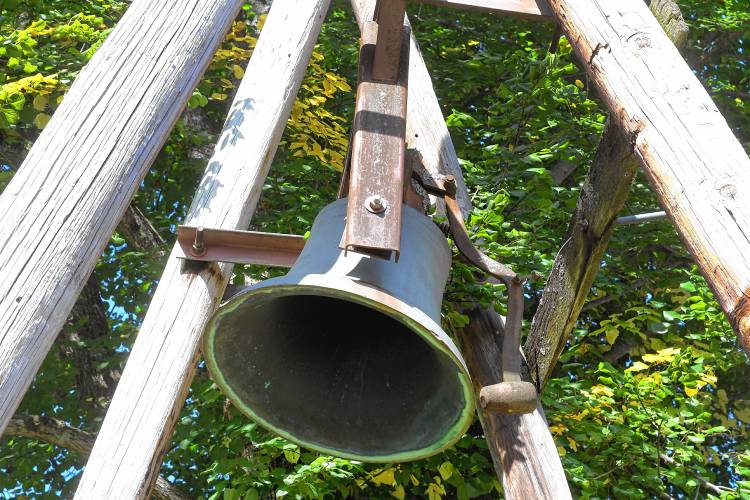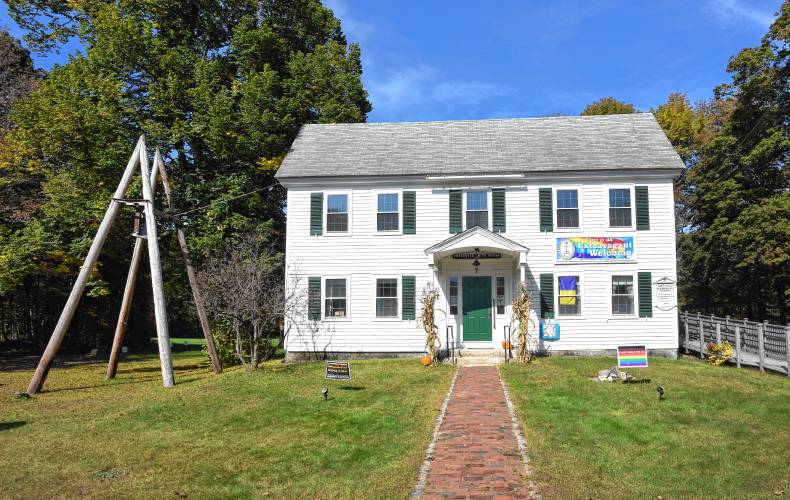40 years of calling residents to worship in Warwick
| Published: 10-06-2023 10:13 AM |
Not far from the town common on Athol Road in Warwick, you’ll come across the Trinitarian Congregational Church. The building looks more like a house than a church. There is no steeple. Look left, though, and you will see a tower made of four 40-foot utility poles fashioned into two A-frames that holds a 1,200-pound bronze bell.
The bell’s story begins in West Troy, New York, where it was manufactured by Meneely & Co. for the second Mount Vernon Church, opened in 1892 and located at the corner of Beacon Street and Massachusetts Avenue in Boston’s Back Bay. A clock and timing mechanism made by the E. Howard Clock Co. of Boston operated the bell, which served the congregation until 1970 when they voted to close Mount Vernon and “enter into covenant” with Old South Church. Soon after, the abandoned church fell prey to squatters and looters. On July 20, 1978, a five-alarm fire decimated what remained of Mount Vernon Church.
One night in the late 1970s, the Boston Police received a tip that a theft was taking place at Mount Vernon. When they arrived, they discovered four young men removing the bell from the scorched bell tower. The officers allowed the men to detach the bell from its cradle and lower it to the ground before arresting them and arranging for the bell’s removal to the Boston Police Evidence Room, where it remained for a time.
The Mount Vernon congregation, under pressure to reclaim it, but no longer needing it, placed an ad in the Massachusetts Conference of the United Church of Christ newsletter, offering the bell for free to any congregation willing and able to carry it away. Michael Caldwell, Trinitarian Congregational Church of Warwick’s student pastor, saw the ad and brought it to the attention of Rod Whipple, a longtime congregant who had often said he believed the Warwick church should have a bell. Whipple had even considered the possibility of the church obtaining a decommissioned bell from a naval vessel. He responded to Mount Vernon’s ad by calling its minister in Boston, who, coincidentally, had gone to school with Trinitarian Congregational Church of Warwick congregant Eleanor Ohlson’s son, Dick Bergquist.
The minister and Whipple reached an agreement. Soon after, Pastor David Ray and church members Tommy Thompson and Dick Whiting drove to Boston. On arrival, they learned that there was one officer on duty in the Evidence Room and no one to help them lug the bell from its pallet to the loading dock and onto Thompson’s pickup truck. By dint of determination, they did it themselves.
They drove the bell to Warwick where it sat in resident Allen Minor’s workshop for two years because, after seeing it, Ray’s father-in-law, an architect, was sure the church roof would not support the weight of a bell tower. His solution was the A-frame and stainless-steel saddle that houses the yoke and bell to this day.
To complete the work, they formed an ad hoc Bell Committee. Its members were Larry Carey, Durward “Stubby” Cornwell, Clyde Perkins Jr., the Rev. David Ray, Tommy Thompson, Rod Whipple and Dick Whiting.
The Mount Vernon bell clapper had been stolen years before the attempted bell theft. Whipple called an officer at the Northfield Congregational Church, which had also been destroyed by fire. It took almost a year, but the Northfield trustees finally agreed to part with their clapper.
Article continues after...
Yesterday's Most Read Articles
 Ja’Duke eyes expansion to Greenfield
Ja’Duke eyes expansion to Greenfield
 My Turn: Quabbin region will never see any benefits from reservoir
My Turn: Quabbin region will never see any benefits from reservoir
 The cool new ‘underground’ spot in town: Le Peacock in Shelburne Falls delivers on colorful décor, people, food and cocktails
The cool new ‘underground’ spot in town: Le Peacock in Shelburne Falls delivers on colorful décor, people, food and cocktails
 Sounds Local: Greenfield’s own Elvis returns to sender: Travis Ledoyt brings ‘The Elvis in Me’ to Greenfield High School, May 25
Sounds Local: Greenfield’s own Elvis returns to sender: Travis Ledoyt brings ‘The Elvis in Me’ to Greenfield High School, May 25
 Renovation of vacant Greenfield house will help those ‘priced out’ of home ownership
Renovation of vacant Greenfield house will help those ‘priced out’ of home ownership
 As I See It: Between Israel and Palestine: Which side should we be on, and why?
As I See It: Between Israel and Palestine: Which side should we be on, and why?
Ashley Webb of Tri-State Precision modified the clapper to fit Warwick’s bell for a cost of $540, for which the church was later reimbursed by an anonymous donor. A local power company donated the utility poles. The saddle’s stainless steel was a donation, too. Whipple’s lifelong friend, Billy Harris, welded the steel. The committee thanked Harris with a case of beer.
On a cold Saturday morning, the ad hoc committee assembled outside the church. They constructed the A-frames on the ground. Minor dug the holes and raised the frames into position with his heavy equipment. The rest of the day they spent attaching the saddle and hanging the yoke and bell.
The bell rang out for the first time at the Trinitarian Congregational Church of Warwick’s Easter sunrise service on April 3, 1983. It has been calling Warwick residents to worship every Sunday morning ever since.
Former Warwick resident Tom Ziniti is chair of the board of deacons at the Trinitarian Congregational Church of Warwick, where he has been a member for 25 years. He now resides in North Orange.





 Speaking of Nature: Indulging in eye candy: Finally, after such a long wait, it’s beginning to look like spring is here
Speaking of Nature: Indulging in eye candy: Finally, after such a long wait, it’s beginning to look like spring is here Celebrating ‘Seasonings’: New book by veteran preacher and poet, Allen ‘Mick’ Comstock
Celebrating ‘Seasonings’: New book by veteran preacher and poet, Allen ‘Mick’ Comstock Faith Matters: How to still the muddy waters of overthinking: Clarity, peace and God can be found in the quiet spaces
Faith Matters: How to still the muddy waters of overthinking: Clarity, peace and God can be found in the quiet spaces A time for every purpose under heaven: Free sing-a-long Pete Seeger Fest returns to Ashfield, April 6
A time for every purpose under heaven: Free sing-a-long Pete Seeger Fest returns to Ashfield, April 6
